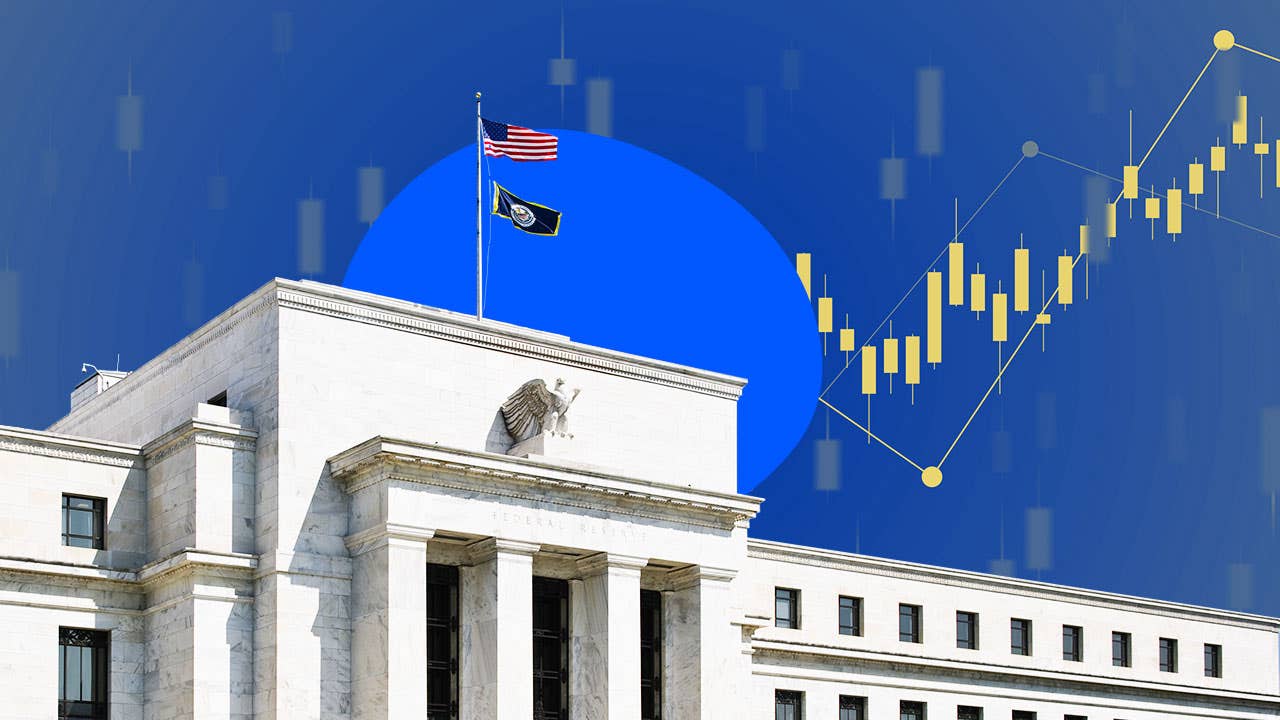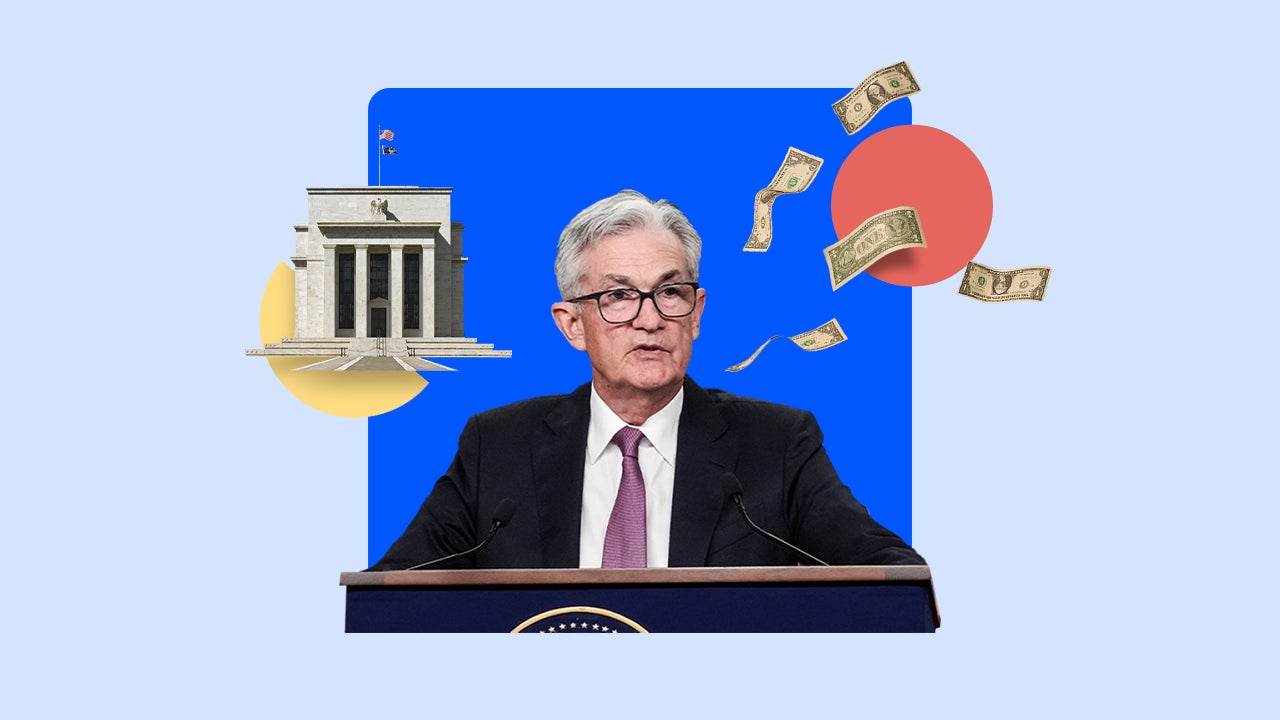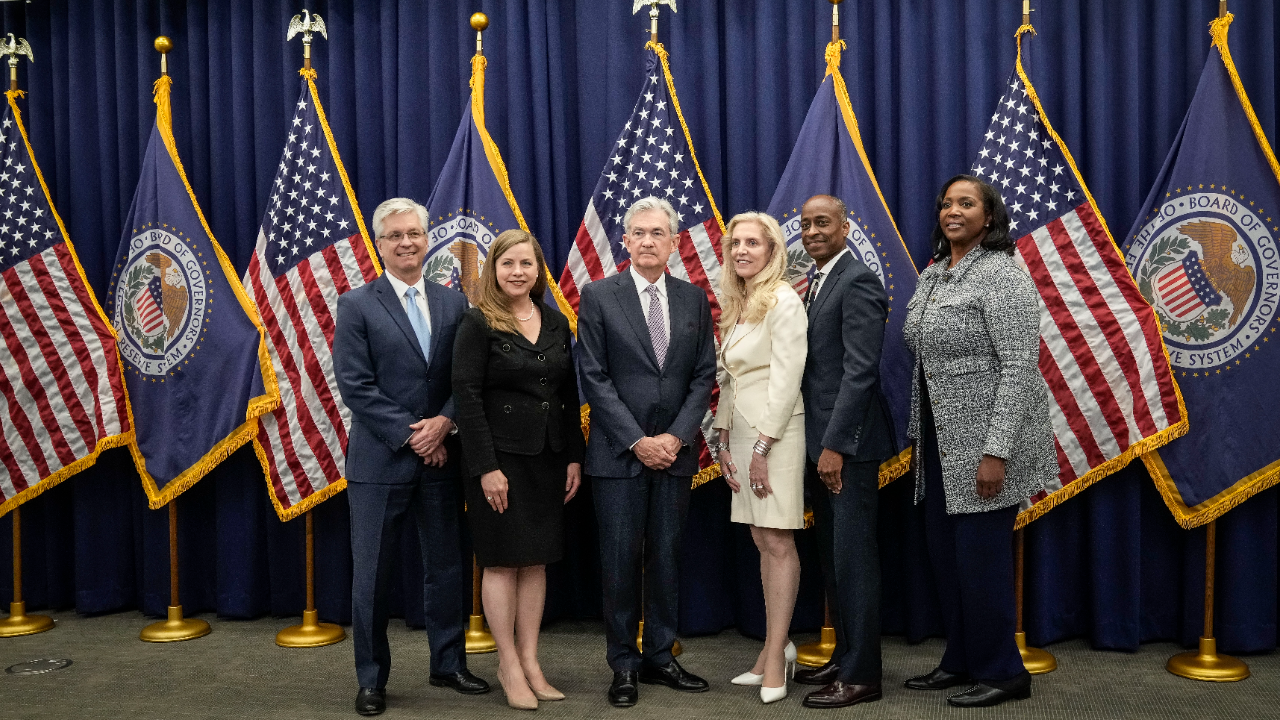Fed’s interest rate history: The federal funds rate from 1981 to the present

Key takeaways
- The Federal Reserve’s key borrowing benchmark is currently in a target range of 4.25-4.5 percent, the highest since 2007.
- The Fed’s monetary policy has shifted significantly over the years, from combating high inflation in the 1980s to dealing with recessions and financial crises in the 2000s and 2010s. The current era is marked by a pandemic and soaring inflation, leading to the most aggressive rate hikes in 40 years.
- The Federal Reserve’s decisions significantly impact the economy, influencing borrowing costs for consumers, employment rates, and inflation. Its current strategy is to avoid volatile rate hikes and maintain a steady approach to managing inflation.
Interest rates from the Federal Reserve are a little bit lower than they used to be, but they’re nowhere near as cheap as they were during the coronavirus pandemic-era.
The U.S. central bank’s key borrowing benchmark is currently in a target range of 4.25-4.5 percent, where it will stay for another seven weeks (at least) after the Federal Open Market Committee (FOMC) voted to keep interest rates unchanged at their March 18-19 rate-setting meeting.
That’s down a full percentage point from its post-pandemic peak of 5.25-5.5 percent. Even so, the federal funds rate remains the highest since 2007, according to a Bankrate analysis of historic Fed moves.
The big question is when the Fed could get back to cutting interest rates. Policymakers are facing a heightened amount of uncertainty as President Donald Trump’s ongoing tariff threats risk reigniting already elevated inflation. Yet, government spending cuts and federal layoffs are also rattling business, consumer and investor confidence, which could potentially weigh on the job market.
When it comes to the world’s most powerful central bank, the past can often be a guide. History, for example, shows that the Fed’s goal of “softly landing” the U.S. economy — bringing down inflation without harming the job market — has proven difficult and elusive. Throughout previous rate-hiking campaigns, officials have rarely been able to slow the economy without kick-starting a recession. Outside of bigger economic meltdowns, policymakers have also tended to cut interest rates gradually, Bankrate’s analysis shows.
To help consumers understand the historical significance of the Fed’s rapid rate hikes in the post-pandemic era, Bankrate compiled this guide of the Fed’s previous rate moves from 1981 to the present. Interest rates may now seem historically high, but they’re currently not that far off from their historic average, the analysis found. Before the Great Recession, the market-driven “effective” federal funds rate averaged 6.38 percent.
Rate moves are expressed in “basis points,” which are equal to 1/100 of a percentage point. For example, a 75 basis point increase is 0.75 percentage point.
While the idea of interest rates coming down is appealing to many consumers and businesses, the reason for lower interest rates is very important. We want interest rates to decline because inflation declines, not because of economic weakness.— Greg McBride, Bankrate Chief Financial Analyst
Fed’s interest rate history of 1981-1990: Volcker fights the ‘Great Inflation’ with historic rate moves and aggressively hawkish monetary policy
The fed funds rate has never been as high as it was in the 1980s.
The main reason is because the Fed wanted to combat inflation, which soared in 1980 to its highest level on record: 14.6 percent.
As a result, the U.S. central bank did something that might seem counterintuitive for an institution that strives to maintain the most productive economy possible: It manufactured a recession to bring prices back down.
The fed funds rate began the decade at a target level of 14 percent in January 1980. By the time officials concluded a conference call on Dec. 5, 1980, they hiked the target range by 2 percentage points to 19-20 percent, its highest ever.
Consumer borrowing costs soared as a result. The average rate on a 30-year fixed-rate mortgage hit the highest on record during the era, spiking to near 20 percent, Bankrate’s historic data shows.
Key insights on the 1981-1990 era
- Fed chair of the decade: Paul Volcker (1979-1987)
- Peak of the decade: 19-20 percent
- Low of the decade: 6 percent
But the Fed has changed almost as much as interest rates since then. Instead of slowly and gradually moving rates in one direction (up or down), interest rates would often rise, then fall, then rise again.
Rates fell sharply to a target range of 13-14 percent on Nov. 2, 1981, then back up to 15 percent in the first four months of 1982, then back down to 11.5-12 percent on July 20, 1982, records of the moves show. The “effective” fed funds rate averaged at 9.97 percent during this 10-year period. Interest rates haven’t eclipsed 10 percent since November 1984.
One reason for the volatility: Chair Paul Volcker decided that the best way to combat inflation involved limiting the growth of the money supply, rather than directly targeting interest rates — the way officials control inflation today.
Other differences between today’s Fed and the Fed of the past include a wider target range for the benchmark fed funds rate, sometimes spanning 5 percentage points instead of the 0.25 percentage point window today. Not to mention, the Fed would adjust rates at unscheduled meetings more often than not, after which it wouldn’t release policy statements.
Chairman Paul Volcker was the main driver of Fed policy in this decade, leading the Fed until Chairman Alan Greenspan took the post in August 1987.
Critics at the time vilified Volcker for harming the economy. Farmers, for example, drove their tractors to the Fed’s headquarters in Washington, D.C., to protest higher interest rates, according to historians at the St. Louis Fed, while car dealers mailed him car keys of unsold vehicles in coffins.
The moves came with a price: Unemployment soared to almost 11 percent, at the time the highest since the Great Depression, historic Bureau of Labor Statistics data shows. Inflation, however, stayed away for years, falling to below 2 percent by 1986.
Fed interest rate history of 1991-2000: Alan Greenspan steers the Fed through a brief recession then presides over ‘Great Moderation’ with a long economic expansion
Fed rate moves
| Meeting date | Rate change | Target |
|---|---|---|
| January 9, 1991: Conference call | -25 basis points | 6.75 percent |
| February 1, 1991: Conference call | -50 basis points | 6.25 percent |
| March 8, 1991: Unscheduled move | -25 basis points | 6 percent |
| April 30, 1991: Conference call | -25 basis points | 5.75 percent |
| Aug. 5, 1991: Conference call | -25 basis points | 5.5 percent |
| Sept. 13, 1991: Conference call | -25 basis points | 5.25 percent |
| Oct. 30, 1991: Conference call | -25 basis points | 5 percent |
| Nov. 5, 1991 | -25 basis points | 4.75 percent |
| Dec. 6, 1991 (After a Dec. 2, 1991, conference call) | -25 basis points | 4.5 percent |
| Dec. 20, 1991 (After Dec. 17, 2001, meeting) | -50 basis points | 4 percent |
| April 9, 1992: Unscheduled move | -25 basis points | 3.75 percent |
| June 30-July 1, 1992 | -50 basis points | 3.25 percent |
| Sept. 4, 1992: Unscheduled move | -25 basis points | 3 percent |
| Feb. 3-4, 1994 | +25 basis points | 3.25 percent |
| March 22, 1994 | +25 basis points | 3.5 percent |
| April 18, 1994: Emergency meeting | +25 basis points | 3.75 percent |
| May 17, 1994 | +50 basis points | 4.25 percent |
| Aug. 16, 1994 | +50 basis points | 4.75 percent |
| Nov. 15, 1994 | +75 basis points | 5.5 percent |
| Jan. 31-Feb. 1, 1995 | +50 basis points | 6 percent |
| July 5- 6, 1995 | -25 basis points | 5.75 percent |
| Dec. 19, 1995 | -25 basis points | 5.5 percent |
| Jan. 30-31, 1996 | -25 basis points | 5.25 percent |
| March 25, 1997 | +25 basis points | 5.5 percent |
| Sept. 29, 1998 | -25 basis points | 5.25 percent |
| Oct. 15, 1998: Emergency meeting | -25 basis points | 5 percent |
| Nov. 17, 1998 | -25 basis points | 4.75 percent |
| June 29-30, 1999 | +25 basis points | 5 percent |
| Aug. 24, 1999 | +25 basis points | 5.25 percent |
| Nov. 16, 1999 | +25 basis points | 5.5 percent |
| Feb. 1-2, 2000 | +25 basis points | 5.75 percent |
| March 21, 2000 | +25 basis points | 6 percent |
| May 16, 2000 | +50 basis points | 6.5 percent |
| Source: Fed’s board of governors | ||
After a tumultuous few years for the Fed during the Great Inflation, Greenspan faced a much calmer period, though that’s not to say he didn’t have his fair share of challenges during his near 18-year tenure at the helm of the Fed.
After an eight-month recession beginning in August 1990, Greenspan and Co. managed to take the fed funds rate all the way up to a target level of 6.5 percent in May 2000, the highest of the period. Rates reached a low of 3 percent in September 1992, the lowest of the decade.
Besides during the early 1990s, the Fed mainly adjusted rates at Federal Open Market Committee (FOMC) meetings, a practice that is in rhythm with today’s Fed. Officials did hike rates on April 19, 1994, at an emergency meeting due to inflation worries, and they cut borrowing costs at an unscheduled Oct. 15, 1998, gathering.
Key insights on the 1991-2000 era
- Fed chair of the decade: Alan Greenspan (1987-2006)
- Peak of the decade: 6.75 percent
- Low of the decade: 3 percent
Another noteworthy feat, the U.S. central bank also made its first “insurance” cuts, meaning officials cut interest rates to give the economy an extra boost, not to fight a recession. Such was the case in 1995, 1996 and 1998, when the financial system confronted a share of headwinds ranging from debt default in Russia to a major hedge fund’s collapse.
The longest-serving Fed chair to date, Greenspan is often nicknamed “maestro” for having steered the economy through the longest economic expansion at the time. The Fed unofficially began identifying 2 percent as its inflation target during this decade — a pivotal decision that would irrevocably change modern monetary policy.
A proponent of deregulation, however, his policies would later be blamed for fueling asset bubbles that led to the dot-com boom and bust and the housing bubble that sparked the 2008 financial crisis.
Fed interest rate history of 2001-2010: Fed faces the dotcom bust, the 9/11 terrorist attacks and the 2008 financial crisis
Rate cuts 2001-2003
| Meeting date | Rate change | Target |
|---|---|---|
| Jan. 3, 2001: Emergency meeting | -50 basis points | 6 percent |
| Jan 30-31, 2001 | -50 basis points | 5.5 percent |
| March 20, 2001 | -50 basis points | 5 percent |
| April 18, 2001: Emergency meeting | -50 basis points | 4.5 percent |
| May 15, 2001 | -50 basis points | 4 percent |
| June 26-27, 2001 | -25 basis points | 3.75 percent |
| Aug. 21, 2001 | -25 basis points | 3.5 percent |
| September 17, 2001: Emergency meeting | -50 basis points | 3 percent |
| Oct. 2, 2001 | -50 basis points | 2.5 percent |
| Nov. 6, 2001 | -50 basis points | 2 percent |
| Dec. 11, 2001 | -25 basis points | 1.75 percent |
| Nov. 6, 2002 | -50 basis points | 1.25 percent |
| June 24-25, 2003 | -25 basis points | 1 percent |
| Source: Fed’s board of governors |
Rate hikes 2004-2006
| Meeting date | Rate change | Target |
|---|---|---|
| June 29-30, 2004 | +25 basis points | 1.25 percent |
| Aug. 10, 2004 | +25 basis points | 1.5 percent |
| Sept. 21, 2004 | +25 basis points | 1.75 percent |
| Nov. 10, 2004 | +25 basis points | 2 percent |
| Dec. 14, 2004 | +25 basis points | 2.25 percent |
| Feb. 1-2, 2005 | +25 basis points | 2.5 percent |
| March 22, 2005 | +25 basis points | 2.75 percent |
| May 3, 2005 | +25 basis points | 3 percent |
| June 29-30, 2005 | +25 basis points | 3.25 percent |
| Aug. 9, 2005 | +25 basis points | 3.5 percent |
| Sept. 20, 2005 | +25 basis points | 3.75 percent |
| Nov. 1, 2005 | +25 basis points | 4 percent |
| Dec. 13, 2005 | +25 basis points | 4.25 percent |
| Jan. 31, 2006 | +25 basis points | 4.5 percent |
| March 28, 2006 | +25 basis points | 4.75 percent |
| May 10, 2006 | +25 basis points | 5 percent |
| June 29, 2006 | +25 basis points | 5.25 percent |
| Source: Fed’s board of governors |
Rate cuts 2007-2008
| Meeting date | Rate change | Target & target range |
|---|---|---|
| Sept. 18, 2007 | -50 basis points | 4.75 percent |
| Oct. 30-31, 2007 | -25 basis points | 4.5 percent |
| Dec. 11, 2007 | -25 basis points | 4.25 percent |
| Jan. 22, 2008: Emergency meeting | -75 basis points | 3.5 percent |
| Jan. 29-30, 2008 | -50 basis points | 3 percent |
| March 18, 2008 | -75 basis points | 2.25 percent |
| April 29-30, 2008 | -25 basis points | 2 percent |
| Oct 8, 2008: Emergency meeting | -50 basis points | 1.50 percent |
| Oct. 28-29, 2008 | -50 basis points | 1 percent |
| Dec. 15-16, 2008 | -100 to 75 basis points | 0-0.25 percent |
| Source: Fed’s board of governors |
The 2000s were the Fed’s most rhythmic period yet, with the Fed following clear cycles for both tightening and loosening rates.
To start the decade, the Fed slashed interest rates 13 times to a low of 1 percent — a range that might’ve been unthinkable for those who remembered rates in the ‘80s — after a stock market bubble in the technology sector burst, kickstarting a recession that was exacerbated by the 9/11 terrorist attacks.
Key insights on the 2001-2010 era
-
Fed chair of the decade:
- Alan Greenspan (1987-2006)
- Ben Bernanke (2006-2014)
- Peak of the decade: 6 percent
- Low of the decade: 1 percent
The U.S. central bank then managed to hike interest rates 17 times between 2004 and 2006 — all of those increases in gradual, quarter-point moves — to a high of 5.25 percent.
That was until the financial crisis of 2008 happened and the ensuing Great Recession, which slammed the brakes on the economy. The Fed then did the unthinkable: It slashed interest rates by 100 basis points to near-zero. Chairman Ben Bernanke led the Fed during this period, which was, at the time, one of its most aggressive economic rescue efforts in Fed history.
During this era, the Fed also unveiled an experimental, unconventional monetary policy tool: quantitative easing, or large scale asset purchases (LSAPs) as they’re formally known. A massive bond-buying program to lower long-term interest rates and give the economy a bigger boost caused the Fed’s balance sheet to balloon, soaring to $4.5 trillion from a starting place of $870 billion.
Fed interest rate history of 2011-2020: The economy recovers from the Great Recession and faces the coronavirus pandemic a decade later
Rate hikes 2015-2018
| Meeting date | Rate change | Target range |
|---|---|---|
| Dec. 15-16, 2015 | +25 basis points | 0.25-0.5 percent |
| Dec. 13-14, 2016 | +25 basis points | 0.5-0.75 percent |
| March 14-15, 2017 | +25 basis points | 0.75-1 percent |
| June 13-14, 2017 | +25 basis points | 1-1.25 percent |
| Dec. 12-13, 2017 | +25 basis points | 1.25-1.5 percent |
| March 20-21, 2018 | +25 basis points | 1.5-1.75 percent |
| June 12-13, 2018 | +25 basis points | 1.75-2 percent |
| Sept. 25-26, 2018 | +25 basis points | 2-2.25 percent |
| Dec. 18-19, 2018 | +25 basis points | 2.25-2.5 percent |
| Source: Fed’s board of governors |
Rate cuts 2019-2020
| Meeting date | Rate change | Target range |
|---|---|---|
| July 30-31, 2019 | -25 basis points | 2-2.25 percent |
| Sept. 17-18, 2019 | -25 basis points | 1.75-2 percent |
| Oct. 29-30, 2019 | -25 basis points | 1.5-1.75 percent |
| March 3, 2020: Emergency meeting | -50 basis points | 1-1.25 percent |
| March 14-15, 2020: Emergency meeting | -100 basis points | 0-0.25 percent |
| Source: Fed’s board of governors |
The Fed couldn’t escape zero rates in the 2010s just as much as it couldn’t escape devastating recessions.
Officials would ultimately end up leaving interest rates at rock-bottom until 2015, after which they only hiked interest rates by 25 basis points once per year. That is, until 2017, when the Fed hiked three times, and 2018, when they hiked four more times. The fed funds rate peaked at 2.25-2.5 percent.
Facing tepid inflation and moderating growth, the Fed also decided in 2019 to cut interest rates three times to give the economy a fresh boost — similar to Greenspan’s “insurance” cuts of the 1990s.
Key insights on the 2011-2020 era
-
Fed chairs of the decade:
- Ben Bernanke (2006-2014)
- Janet Yellen (2014-2018)
- Jerome Powell (2018-Present)
- Peak of the decade: 2.25-2.5 percent
- Low of the decade: 0-0.25 percent
The fed funds rate looked like it was about to settle there until the coronavirus pandemic came along, ushering back in another era of near-zero rates. The Fed slashed rates to zero across two emergency meetings within 13 days of each other as the gears of the economy came to a halt.
Chair Janet Yellen took the helm of the Fed from Bernanke in February 2014 and steered the economy through its Great Recession recovery until February 2018, when Chair Jerome Powell was installed.
Fed interest rate today 2021-present: The Fed’s latest moves in an era of soaring inflation
Rate hikes 2022-July 2023
| Meeting date | Rate change | Target range |
|---|---|---|
| March 15-16, 2022 | +25 basis points | 0.25-0.5 percent |
| May 3-4, 2022 | +50 basis points | 0.75-1 percent |
| June 14-15, 2022 | +75 basis points | 1.50-1.75 percent |
| July 26-27, 2022 | +75 basis points | 2.25-2.5 percent |
| Sept. 20-21, 2022 | +75 basis points | 3-3.25 percent |
| Nov. 1-2, 2022 | +75 basis points | 3.75-4 percent |
| Dec. 13-14, 2022 | +50 basis points | 4.25-4.5 percent |
| Jan. 31-Feb. 1, 2023 | +25 basis points | 4.5-4.75 percent |
| March 21-22, 2023 | +25 basis points | 4.75-5 percent |
| May 2-3, 2023 | +25 basis points | 5-5.25 percent |
| July 25-26, 2023 | +25 basis points | 5.25-5.5 percent |
| Source: Fed’s board of governors |
Rate cuts 2024-?
| Meeting date | Rate change | Target range |
|---|---|---|
| Sept. 17-18, 2024 | -50 basis points | 4.75-5 percent |
| Nov. 6-7, 2024 | -25 basis points | 4.5-4.75 percent |
| Dec. 17-18, 2024 | -25 basis points | 4.25-4.5 percent |
| Source: Fed’s board of governors |
It’s been a blast from the past for Fed rate-setting, with inflation returning as the No. 1 economic threat in the aftermath of the coronavirus crisis.
The Fed hiked interest rates by a quarter point in March 2022 for the first time since 2018, leaving interest rates at near-zero percent for two years to give the economy time to recover from the coronavirus pandemic. They didn’t stop breaking milestones there. The Fed approved the largest rate hike since 2000 during its May gathering when it raised interest rates by half a percentage point, as well as the largest rate hike since 1994 when it lifted interest rates by three-quarters of a percentage point in June. The Fed followed up on that historic move with three additional increases of that size.
Officials felt comfortable leaving their foot on the gas even as inflation soared to a 40-year high — in part, because they were guided under a false assumption that massive price pressures were only temporary.
Experts say U.S. central bankers usually worry about the wrong conflict. Just how officials spent the 1990s worried about inflation, the Fed probably spent the early 2020s fearing too-low inflation, says Scott Sumner, monetary policy chair emeritus at George Mason University’s Mercatus Center.
“Central banks tend to focus on fighting the last war,” Sumner says. “If you have a lot of inflation, you get a more hawkish stance. If you’ve undershot your inflation target, then the Fed thinks, ‘Well, maybe we should’ve been more expansionary.’ Powell came into his job with that determination, that if there was another recession, they would be more aggressive. My own view is that the strategy was relatively successful at first but pushed too far.”
Key insights on the 2021-2022 era
- Fed chair of the decade: Jerome Powell (2018-Present)
- Peak of the decade: 5.25-5.5 percent
- Low of the decade: 0-0.25 percent
By many standards, however, an entirely different U.S. central bank is steering the boat, meaning officials don’t want to tame inflation with aggressive, volatile rate hikes similar to the 1980s, he adds. Yet, officials have also spoken out against the stop-and-go manner of rate hikes leading up to the Great Inflation of the 1980s.
“The successful Volcker disinflation in the early 1980s followed multiple failed attempts to lower inflation over the previous 15 years,” Powell said in a pivotal 2022 speech at the Fed’s annual monetary policy symposium in Jackson Hole, Wyoming. “Our aim is to avoid that outcome by acting with resolve now.”
Prices in February rose 2.8 percent from a year ago, more than three times slower than the eye-popping 9.1 percent annual rate from June 2022, according to the Bureau of Labor Statistics consumer price index (CPI). Excluding the more volatile food and energy categories, so-called core inflation is up 3.1 percent from a year ago, BLS data also shows.
At the same time, unemployment has risen, and job growth has slowed markedly since the Fed started raising interest rates. Officials have implied that they no longer want interest rates to be slamming the brakes on economic growth as forcefully. The fear of harming economic growth was a primary motivation behind the Fed’s three cuts in 2024.
Bottom line
Even with three interest rate cuts so far, Fed officials appear poised to keep interest rates high — so long as inflation stays elevated and the economy holds up. Concentrate on eliminating high-interest debt, boosting your credit score and shopping around for the best places where you can park your cash, so your money is rewarded.
“Interest rates took the elevator going up, but they’ll be taking the stairs coming down,” McBride says. “Interest rates won’t fall fast enough to bail you out of a tight situation.”
You may also like

Average business line of credit interest rates





